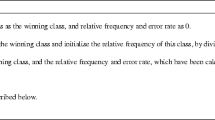Summary
The process of computation of classification trees can be characterized as involving three basic choices: the type of splits considered in the growing process, the criterion to be optimized at each step of the process, and the way to get right-sized trees. Most implementations are ordinary binary trees, i.e. trees whose successive cuts are made by hyper-planes perpendicular to the axes. L. Devroye, L. Györfy and G. Lugosi (1996) define and consider the remarkable theoretical properties of a binary tree classifier whose prominent feature is the particular type of splits used in its construction: at a given node, partitioning is made by hyper-rectangles rather than hyper-planes. We propose an approximation of the solution for the complex optimization problem involved to allow insights on the practical advantages of those trees. Then we compare the performance of our algorithm with some leading algorithms for ordinary binary trees, namely CART and C4.5 as implemented in the Splus “tree” procedure and in SAS’s Enterprise Miner respectively.









Similar content being viewed by others
References
Breiman, L., Friedman, J., Olshen, R. & Stone, C. (1984),Classification and Regression Trees., Wadsworth International, Belmont, CA.
Buntine, W. & Caruana, R. (1992),Introduction to IND Version 2.1 and Recursive Partitioning, NASA Ames Research Center, Moffet Field, CA.
Clark, L. & Pregibon, D. (1993), Tree-based models,in J. Chambers & T. Hastie, eds,‘Statistical Models in S’ Chapman & Hall, New York, NY, pp. 377–419.
Devroye, L., Gyorfi, L. & Lugosi, G. (1996),A probabilistic theory of pattern recognition., Springer-Ver lag, New-York.
Esposito, F., Malerba, D. & Semeraro, G. (1997),‘A comparative analysis of methods for pruning decision trees.’IEEE Transactions on pattern analysis and machine intelligence 19(5), 476–491.
Friedman, J. & Fisher, N. (1999),‘Bump hunting in high-dimensional data’Statistics and Computing 9(2), 123–143.
Michie, D., Spiegelhalter, D. J. & Taylor, C. C. (1994),Machine Learning, neural and statistical classification., Ellis Horwood.
Muller, W. & Wysotzki, F. (1997), The decision tree algorithm CAL5 based on a statistical approach to its splitting algorithm,in‘Machine Learning and Statistics: The Interface’ John Wiley & Sons, New York, NY, pp. 45–65.
Murphy, P. M. & Aha, D. W. (1996),UCI Repository of machine learning databases., Department of Information and Computer Science, University of California, Irvine, CA.
Quinlan, J. R. (1993),C4.5: Programs for Machine Learning, San Mateo, CA: Morgan Kaufmann.
Shih, Y.-S., Lim, T.-S. & Loh, W.-Y. (2000),‘A comparison of prediction accuracy, complexity and training time of thirty-three old and new classification algorithms’Machine Learning 40, 203–228.
Venables, W. & Ripley, B. (1994),Modern Applied Statistics with S-Plus, New-York, NY: Springer-Verlag.
Author information
Authors and Affiliations
Additional information
Research support from “Projet d’Actions de Recherche Concertées” (No. 98/03-217) and from the “Interuniversity Attraction Pole“, Phase V (No. P5/24) from the Belgian Government are also acknowledged.
Rights and permissions
About this article
Cite this article
De Macq, I., Simar, L. Hyper-rectangular space partitioning trees: A practical approach. Computational Statistics 20, 119–135 (2005). https://doi.org/10.1007/BF02736126
Published:
Issue Date:
DOI: https://doi.org/10.1007/BF02736126




